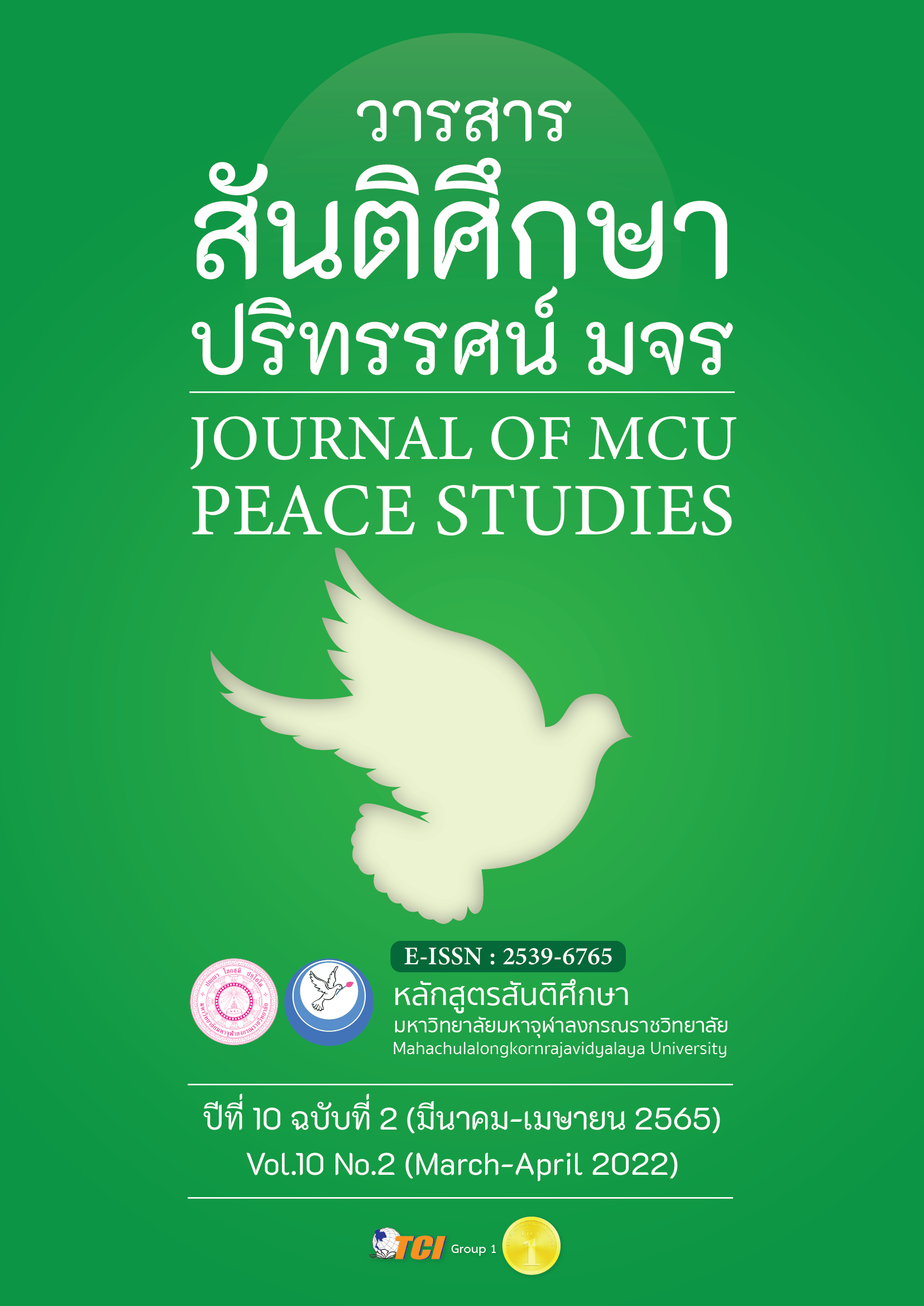The Model of Marketing Strategies Influencing Customer Satisfaction of Supermarkets in Bangkok Areas
Main Article Content
บทคัดย่อ
The purposes of this research were: 1) to study marketing strategies of supermarkets in Bangkok areas; 2) to study customer satisfaction towards supermarkets in Bangkok areas;
3) to find a relationship between marketing strategies and customer satisfaction; 4) to analyze marketing strategies that have an influence on customer satisfaction; and 5) to present the model of marketing strategies influencing customer satisfaction. The samples used in this study were 380 participants who are customers of the selected Tesco Lotus and Big C supermarkets in Bangkok areas. The research questionnaire was used as a tool to collect data. Statistics used in this study consisted of Percentage, Mean, Standard Deviation, Pearson Correlation and Multiple Regression Analysis.
The research results were found that: 1) The overall marketing strategies of supermarkets were perceived at the highest level. In particular, product was perceived at the highest level, followed by promotion, price and place. 2) The overall customer satisfaction was at high level. In particular, customers perceived full meeting of expectation at high level, followed by repeat purchase, positive attitudes towards supermarkets, and positive word-of-mouth recommendation. 3) Marketing strategies were positively related to customer satisfaction. 4) Marketing strategies had an influence on customer satisfaction. In particular, price had the highest influence on customer satisfaction, followed by product, promotion and place. The model of marketing strategies derived from this research is called the “VACAS” model, consisting of various products (V), acceptable price (A), customer responsiveness (C), accessible place (A), and service minded (S). This model can be implemented to create positive attitudes, customer satisfaction, purchase intention, repeat purchase, customer retention and customer loyalty leading to increased market share, increased profitability, branch expansion, and sustainable growth of the business. Recommendations were that supermarkets should distribute high quality products that meet customer expectation with acceptable price to increase customer satisfaction.
Article Details

อนุญาตภายใต้เงื่อนไข Creative Commons Attribution-NonCommercial-NoDerivatives 4.0 International License.
ทัศนะและความคิดเห็นที่ปรากฏในบทความในวารสาร ถือเป็นความรับผิดชอบของผู้เขียนบทความนั้น และไม่ถือเป็นทัศนะและความรับผิดชอบของกองบรรณาธิการ ยินยอมว่าบทความเป็นลิขสิทธิ์ของวารสาร
เอกสารอ้างอิง
Bangphlat District Office. (2020). Population statistics. Bangkok: Bangphlat District Office.
Barnes, J.G. (1994). Close to the Customer: But Is It Really a Relationship? Journal of Marketing Management, 10, 561-570.
Bowen, J.T., & Chen, S.L. (2001). The Relationship between Customer Loyalty and Customer Satisfaction. International Journal of Contemporary Hospitality Management, 13(5), 213-217.
Brand Inside Website. (2021). Ranking of most popular retailed stores: Lotus ranked number 1, followed by Big C and Makro. Retrieved May 14, 2021 from www.https://brandinside.asia.
Bruhn, M. (2003). Relationship marketing: Management of customer relationships. London: Prentice Hall.
Channuwong, S. (2014). The Strategic Management of Coca-Cola and Starbucks Company. TNI Journal of Business Administration and Language, 2(2), 55-58.
Chui, S., Lui, C., & Tu, J. (2016). The Influence of Tourists’ Expectations on Purchase Intention: Linking Marketing Strategies for Low-Cost Airlines. Journal of Air Transport Management, 53, 226-234.
Crosby, L.A., Evans, K.R., & Cowles, D. (1990). Relationship Quality in Services Selling: An Interpersonal Influence Perspective. Journal of Marketing, 54, 68-81.
East, R. (1997). Consumer behavior: Advances and applications in marketing. London: Prentice Hall.
Heskett, J.L. (2002). Beyond Customer Loyalty. Journal of Managing Service Quality, 12(6), 355-357.
Heskett, J.L. et al. (1994). Putting the Service-profit Chain to Work. Harvard Business Review, 72(4), 164-174.
Huber, F., Herrmann, A., & Wricke, M. (2001). Customer Satisfaction as an Antecedent of Price Acceptance: Results of an Empirical Study. Journal of Product & Brand Management, 10(3), 160-169.
Jones, R., & Rowley, J. (2011). Entrepreneurial Marketing in Small Businesses: A Conceptual Exploration. International Small Business Journal, 29, 25-36.
Kotler, P., Wong, V., Saunders, J., & Armstrong, G. (2005). Principle of Marketing. Essex, U.K.: Pearson Education Limited.
Leechaimongkol, C., Seesupan, T., & Narakorn, P. (2021). The Service Marketing Mix Factors Affecting Decision of Farmers on Choosing Service Paddy to Rice Maket in Amphoe Muang Changwat Phitsanulok. Humanities and Social Sciences Journal of Pibulsongkram Rajabhat University, 15(1), 79-90.
Levesque, T., & McDougall, G.H.G. (1996). Determinants of Customer Satisfaction in Retail Banking. International Journal of Bank Marketing, 14(7), 12-20.
Oliva, T.A., Oliver, R.L., & MacMillan, I.C. (1992). A Catastrophe Model for Developing Service Satisfaction Strategies. Journal of Marketing, 56, 83-95.
Oliver, R.L. (1996). Satisfaction: A behavioral perspective on the consumer. New York: McGrawHill.
Oliver, R.L. (1999). Whence Customer Loyalty? Journal of Marketing, 63, 33-44.
Parasuraman, A., Zeithaml, V.A., & Berry, L.L. (1988). SERVQUAL: A Multiple Item Scale for Measuring Customer Perceptions of Service Quality. Journal of Retailing, 64, 12-40.
Parasuraman, A., Zeithaml, V.A., & Berry, L.L. (2013). A Conceptual Model of Service Quality and Its Implications for Future Research. Journal of Marketing, 49, 41-50.
Phra Nakhon District Office. (2020). Population statistics. Bangkok: Phra Nakhon District Office.
Rowley, J. (2005). The Four Cs of Customer Loyalty. Journal of Marketing Intelligence & Planning, 23(6), 574-581.
Schellhase, R., Hardock, P., & Ohlwein, M. (2000). Customer Satisfaction in Business-to-Business Marketing: The Case of Retail Organizations and their Suppliers. Journal of Business & Industrial Marketing, 13(2), 106-121.
Sheth, J.N., & Sisodia, R.S. (1999). Revisiting Marketing’s Lawlike Generalizations. Journal of the Academy of Marketing Sciences, 17(1), 71-87.
Szymanski, D.M., & Henard, D.D. (2001). Customer Satisfaction: A Meta-analysis of the Empirical Evidence. Journal of the Academy of Marketing Science, 29(1), 16-35.
Tepeci, M. (1999). Increasing Brand Loyalty in the Hospitality Industry. International Journal of Contemporary Hospitality Management, 11(5), 223-229.
Thongsrikhow, N., & Tuntrakul, T. (2020). The Competitive Factors of Laminated Floorcovering Market in Thailand. Journal of MCU Peace Studies, 8(6), 2055-2067.
Verhoef, P. C., Reinartz, W. J., & Krafft, M. (2010). Customer Engagement as a New Perspective in Customer Management. Journal of Service Research, 13(3), 247-252.


